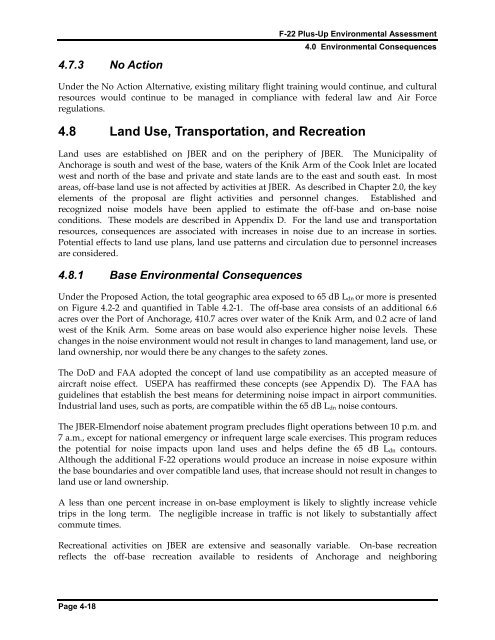F-22 Plus-Up Environmental Assessment - Joint Base Elmendorf ...
F-22 Plus-Up Environmental Assessment - Joint Base Elmendorf ...
F-22 Plus-Up Environmental Assessment - Joint Base Elmendorf ...
You also want an ePaper? Increase the reach of your titles
YUMPU automatically turns print PDFs into web optimized ePapers that Google loves.
4.7.3 No Action<br />
F-<strong>22</strong> <strong>Plus</strong>-<strong>Up</strong> <strong>Environmental</strong> <strong>Assessment</strong><br />
4.0 <strong>Environmental</strong> Consequences<br />
Under the No Action Alternative, existing military flight training would continue, and cultural<br />
resources would continue to be managed in compliance with federal law and Air Force<br />
regulations.<br />
4.8 Land Use, Transportation, and Recreation<br />
Land uses are established on JBER and on the periphery of JBER. The Municipality of<br />
Anchorage is south and west of the base, waters of the Knik Arm of the Cook Inlet are located<br />
west and north of the base and private and state lands are to the east and south east. In most<br />
areas, off-base land use is not affected by activities at JBER. As described in Chapter 2.0, the key<br />
elements of the proposal are flight activities and personnel changes. Established and<br />
recognized noise models have been applied to estimate the off-base and on-base noise<br />
conditions. These models are described in Appendix D. For the land use and transportation<br />
resources, consequences are associated with increases in noise due to an increase in sorties.<br />
Potential effects to land use plans, land use patterns and circulation due to personnel increases<br />
are considered.<br />
4.8.1 <strong>Base</strong> <strong>Environmental</strong> Consequences<br />
Under the Proposed Action, the total geographic area exposed to 65 dB L dn or more is presented<br />
on Figure 4.2-2 and quantified in Table 4.2-1. The off-base area consists of an additional 6.6<br />
acres over the Port of Anchorage, 410.7 acres over water of the Knik Arm, and 0.2 acre of land<br />
west of the Knik Arm. Some areas on base would also experience higher noise levels. These<br />
changes in the noise environment would not result in changes to land management, land use, or<br />
land ownership, nor would there be any changes to the safety zones.<br />
The DoD and FAA adopted the concept of land use compatibility as an accepted measure of<br />
aircraft noise effect. USEPA has reaffirmed these concepts (see Appendix D). The FAA has<br />
guidelines that establish the best means for determining noise impact in airport communities.<br />
Industrial land uses, such as ports, are compatible within the 65 dB L dn noise contours.<br />
The JBER-<strong>Elmendorf</strong> noise abatement program precludes flight operations between 10 p.m. and<br />
7 a.m., except for national emergency or infrequent large scale exercises. This program reduces<br />
the potential for noise impacts upon land uses and helps define the 65 dB L dn contours.<br />
Although the additional F-<strong>22</strong> operations would produce an increase in noise exposure within<br />
the base boundaries and over compatible land uses, that increase should not result in changes to<br />
land use or land ownership.<br />
A less than one percent increase in on-base employment is likely to slightly increase vehicle<br />
trips in the long term. The negligible increase in traffic is not likely to substantially affect<br />
commute times.<br />
Recreational activities on JBER are extensive and seasonally variable. On-base recreation<br />
reflects the off-base recreation available to residents of Anchorage and neighboring<br />
Page 4-18
















